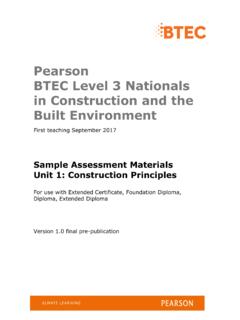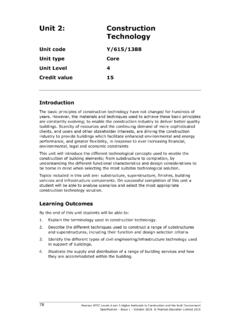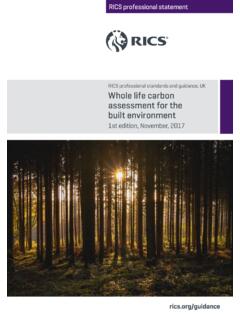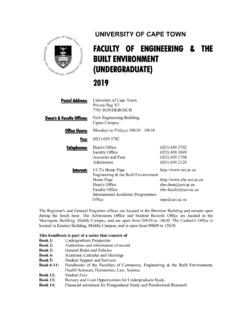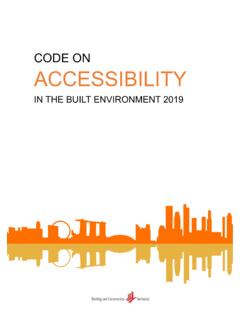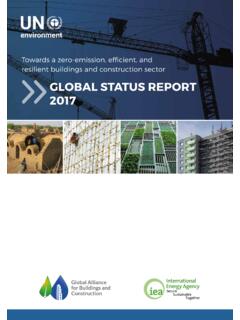Transcription of Unit 9: Measuring, Estimating and Tendering Processes in ...
1 Edexcel BTEC Level 3 Nationals specification in construction and the built environment Issue 1 January 2010 Edexcel Limited 20091 Unit 9: measuring , Estimating and Tendering Processes in construction and the built EnvironmentUnit code: F/600/0223 QCF Level 3: BTEC NationalsCredit value: 10 Guided learning hours: 60 Aim and purposeThis unit gives learners an understanding of the Processes and techniques involved in measuring , Estimating and Tendering . It also gives learners an opportunity to develop skills in producing final quantities, calculating all-in rates and determining the approximate value of building projects. Unit introductionEstimating is concerned with the Processes used by contractors to establish the cost to themselves of carrying out construction work. Tendering is concerned with the commercial aspects of bidding for and obtaining work from contracting companies by selecting contractors and asking them to tender and submit a price for the project , and the accurate estimation of the cost of construction work, is crucial to providing meaningful cost information for the construction firm and the client.
2 The process of bidding for a construction contract normally involves the contractor measuring the works required accurately and using the outcomes to estimate the costs and compile the and the estimation of costs are closely linked to the practical activity of construction work. The estimator needs a detailed knowledge of the relevant operations and Processes involved in the construction of building elements, and will need to be able to use this knowledge to perform accurate calculations relating to the projected and final costs of materials, plant and is the process of obtaining a price for the client s work. This is done by issuing the documents needed to prepare the estimate, selecting contractors to bid, and evaluating the prices received in order to award the contract. Tenders are then evaluated for accuracy and checked numerically to ensure that no mistakes have been made before formal acceptance and the issue of contract documents to the successful will have the opportunity to obtain detailed quantities from drawings and other documents, estimate the cost of a variety of construction works, convert the estimate into a tender and provide outline cost estimates for proposed construction BTEC Level 3 Nationals specification in construction and the built environment Issue 1 January 2010 Edexcel Limited 20092 Learning outcomesOn completion of this unit a learner should.
3 1 Be able to produce final quantities from dimensions and descriptions of construction work2 Understand the purpose of Estimating and the common techniques used to price construction work3 Be able to calculate all-in rates of materials, labour and plant4 Be able to derive approximate quantities and costs to determine the approximate value of building projects5 Understand the process of BTEC Level 3 Nationals specification in construction and the built environment Issue 1 January 2010 Edexcel Limited 2009 Unit content1 Be able to produce final quantities from dimensions and descriptions of construction workApplications: detailed measurement and production of quantities eg descriptions for bills of quantities, variations, interim payments, final account work, claims, disputesProcesses: traditional; cut and shuffleProduction of accurate descriptions and quantities: compilation of descriptions for works; mensuration techniques; calculation of quantities (volume, area, lengths) Application of standard methods of measurement: Standard Method of Measurement for Building Work; Civil Engineering Standard Method of Measurement2 Understand the purpose of Estimating and the common techniques used to price construction workPurposes of Estimating : Estimating net cost; pricing of preliminaries; profit and general overheads; the effects of quantity and value on the chosen method of estimatingEstimating techniques: labour, plant and materials; rates per unit of measurement; standard price book rates; output tables; historical rates; work studyDocumentation: Code of Estimating Practice3 Be able to calculate all-in rates of materials, labour and plantMaterial costs: calculation of material quantities.
4 Cost of construction works based on unit costs of materialsLabour rates: calculation of all-in rates for craft workers (skilled, unskilled, gang rates); application of labour costs in unit rates; definition of prime cost of daywork; comparison with all-in ratesPlant rates: calculation of fixed and operating costs; calculation of hourly rates; application of plant costs in unit ratesCalculation of unit rates for various classes of construction work: eg excavation, masonry, concrete work, underground drainage, structural steelwork, suspended timber floors, roof construction , roof coverings, plastering, dry linings, painting and decorating, plumbing work, electrical installation, glazing4 Be able to derive approximate quantities and costs to determine the approximate value of building projects Traditional cost modeling: approximate Estimating techniques; cost per unit, eg bed, seat, pupil, space; cost per unit area eg m2 of gross floor area, m2 of functional space; cost of functional element; approximate quantitiesApplication: eg feasibility studies, pre-contract cost planning, control, links to stages of RIBA Architect s Plan of WorkProcesses: eg use of historical data, tender price indices, location factors, wall-to-floor ratios, window-to-floor ratios, plan shape, number of storeysEdexcel BTEC Level 3 Nationals specification in construction and the built environment Issue 1 January 2010 Edexcel Limited 200945 Understand the process of tenderingCommon methods of Tendering : methods of Tendering relevant to the scale, size and value of the construction works; type of work (building, civil engineering or building services work) for a range of construction works (eg single stage selective, two stage selective, open, serial); target cost; measured term.
5 Fee bidding Documentation: eg drawings, schedules, specifications, schedules of work, bills of quantities, activity schedules; codes of procedure for Tendering relevant to main and principal contractors, sub-contract packages and supply packagesFactors affecting the level of tenders: impact on value, price or level of a tender for main and principal contractors, sub-contract and supply packages; profit element; potential variations; quality of tender document; standard form of contract; amended standard form or bespoke contract forms; local authority conditions5 Edexcel BTEC Level 3 Nationals specification in construction and the built environment Issue 1 January 2010 Edexcel Limited 2009 Assessment and grading criteriaIn order to pass this unit, the evidence that the learner presents for assessment needs to demonstrate that they can meet all the learning outcomes for the unit. The criteria for a pass grade describe the level of achievement required to pass this and grading criteriaTo achieve a pass grade the evidence must show that the learner is able to:To achieve a merit grade the evidence must show that, in addition to the pass criteria, the learner is able to:To achieve a distinction grade the evidence must show that, in addition to the pass and merit criteria, the learner is able to.
6 P1 carry out the measurement of quantities for different applications [IE4, SM2]M1 apply the Standard Method of Measurement to the production of accurate quantities and descriptionsP2 abstract final quantities from measurements[IE4, IE6, SM3]M2 justify the selection of a new Estimating methodP3 explain the purposes of Estimating [IE1, IE3, IE4, IE6, RL5, RL6]M3 justify the selection of an appropriate Tendering evaluate the limitations of pre-production costing methodsP4 explain the uses of different Estimating techniquesP5 review the content of a given estimate [IE1, IE3, IE4, IE6, RL5, RL6, TW1]P6 determine labour and plant rates, and material costs [IE4, RL1, RL2, RL3, SM2]P7 produce all-in rates for two classes of construction workP8 select techniques and Processes for use in determining costsP9 produce approximate quantities and associated cost budgets for two stages of a construction project[IE4, IE6, SM3]P10 explain the common methods of Tendering for construction workEdexcel BTEC Level 3 Nationals specification in construction and the built environment Issue 1 January 2010 Edexcel Limited 20096 Assessment and grading criteriaTo achieve a pass grade the evidence must show that the learner is able to:To achieve a merit grade the evidence must show that, in addition to the pass criteria, the learner is able to:To achieve a distinction grade the evidence must show that, in addition to the pass and merit criteria, the learner is able to.
7 P11 discuss the documentation required to support the Tendering processP12 explain the factors that can affect the level of evaluate the impact of potential variations on the level of : This summary references where applicable, in the square brackets, the elements of the personal, learning and thinking skills which are embedded in the assessment of this unit. By achieving the criteria, learners will have demonstrated effective application of the referenced elements of the skills. KeyIE independent enquirersCT creative thinkersRL reflective learners TW team workersSM self-managersEP effective participators7 Edexcel BTEC Level 3 Nationals specification in construction and the built environment Issue 1 January 2010 Edexcel Limited 2009 Essential guidance for tutorsDelivery Tutors delivering this unit have opportunities to use a wide range of techniques. Lectures, discussions, seminar presentations, guest speakers, research using the internet and/or library resources and use of personal and/or industrial experience are all suitable.
8 Delivery should stimulate, motivate, educate and enthuse learners. Visiting quantity surveyors could add to the relevance of the recording of measurements should follow the use of industry-standard methods, using taking-off sheets for either the traditional or cut and shuffle methods of processing into finished quantities. Whichever approach is adopted, the alternative method should also be demonstrated and the advantages and disadvantages of each method explained. Similarly, the production of bills of quantities should follow industry-standard formats and layouts. Learners should be encouraged to follow a logical and methodical approach to the Processes of measurement, Tendering and Estimating , and to develop appropriate descriptions of the work they are measuring . Reference to the appropriate standard method of measurement will provide a useful guide. The unit should develop learner awareness and understanding of, rather than the ability to use, relevant computer software and its application of different Estimating methods to different types of construction work should be demonstrated and learners should have the opportunity to calculate rates and prices for a variety of different types of construction work.
9 The emphasis should be on applying principles as well as calculating realistic prices. As part of the Estimating process, calculation of all-in rates for labour and plant resources will be a feature, as will the pricing of preliminary items and the factors to be considered when calculating general overheads and profit. Learners should be made aware of the procedures and Processes involved in managing the initial enquiry through to the tender, and of the differences between the Estimating and Tendering stages of the possible, links should be formed with industry in order to obtain real examples of measurement, Estimating and Tendering documentation and specialist input from current delivery of the unit should be supported by the use of case studies and visual media, where appropriate, including documentation and project drawings to illustrate and contextualise the methods used for measurement, Estimating and activities are permissible, but tutors will need to ensure that individual learners have equal experiential and assessment opportunities, and produce individual evidence for , safety and welfare issues are paramount and should be reinforced through close supervision of all workshops and activity areas.
10 And risk assessments must be undertaken before practical activities are taken. Centres are advised to read the Delivery approach section in the specification, and Annexe H: Provision and Use of Work Equipment Regulations 1998 (PUWER).Edexcel BTEC Level 3 Nationals specification in construction and the built environment Issue 1 January 2010 Edexcel Limited 20098 Outline learning planThe outline learning plan has been included in this unit as guidance and can be used in conjunction with the programme of suggested outline learning plan demonstrates one way in planning the delivery and assessment of this unit. Topic and suggested assignments/activities and/assessmentUnit introduction and SMM7 rules presentation by tutorThe SMM7 and the CESMM individual researchTaking off quantities: areas, volumes, items, number and length practical exercises Understanding drawn information and centre line calculation demonstration by tutor Taking-off: individual practice exercisesTake offs for various different sections of the Standard Method of MeasurementTaking-off quantities foundation and substructure of small buildingTechnology of substructure tutor inputTake off lists compiled Practical exercisesCompletion of take off in learner s timeAssignment 1: Measurement ProcessesEstimating methods types, differences, accuracy theory sessionThe bill of quantities preliminaries.










